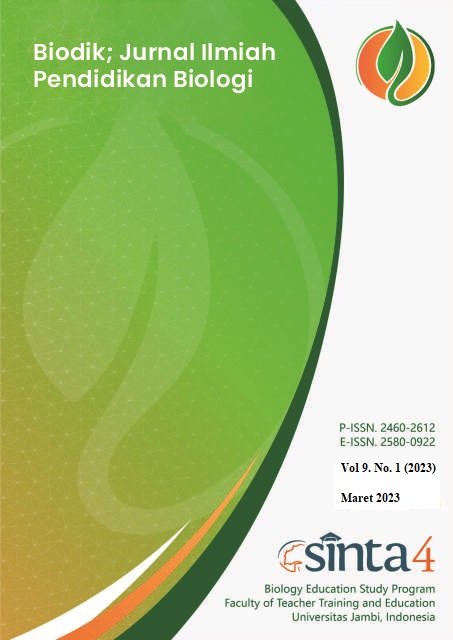Penerapan Strategi Pembelajaran Kooperatif Tipe NHT Untuk Meningkatkan Hasil Belajar Siswa Dikelas XI SMA Hang Tuah Belawan
(Application of the NHT Type Cooperative Learning Strategy to Improve Student Learning Outcomes in Class XI SMA Hang Tuah Belawan)
DOI:
https://doi.org/10.22437/bio.v9i1.19268Abstract
Learning results are a portrayal of how understudies grasp the material presented by the educator. Learning results are output values as numbers or letters that understudies get in the wake of getting learning material through a test or test given by the educator. From the learning results, the educator can get data on how far understudies comprehend the material being considered. The objectives of this study hall activity research are, first, to fulfill the tasks of the Classroom Action Research Course. second, to research and implement NHT type cooperative learning strategies in improving understudy learning results. This examination was led at the HANG TUAH BELAWAN SMA school, with the research subjects namely the Principal, Teachers and Students as many as 72 people consisting of 37 men and 35 women, and using 2 classrooms. The sort of exploration use. In this classroom action research, it consists of 2 cycles, 1 cyclec on sists of 2 meetings, if there are 2 cycles, it means that it consists of 4 meetings. Each cycle comprises of 4 phases, specifically: Planning, Action Implementation, Observation, furthermore, Reflection. The instruments utilized in this study were interviews, perceptions, filling in student worksheets, learning out comes tests (pretest and posttest), and documentatio.
Key words: NNT, learning outcomes, students, intruments
Â
ABSTRAK
Hasil belajar merupakan gambaran bagaimana siswa menangkap materi yang disampaikan oleh pendidik. Hasil belajar adalah nilai keluaran berupa angka atau huruf yang diperoleh siswa setelah mendapatkan materi pembelajaran melalui tes atau ulangan yang diberikan oleh pendidik. Dari hasil belajar tersebut, pendidik dapat memperoleh data seberapa jauh pemahaman peserta didik terhadap materi yang sedang dipelajari. Tujuan dari penelitian kegiatan ruang belajar ini adalah, pertama, untuk memenuhi tugas mata kuliah Penelitian Tindakan Kelas. kedua, meneliti dan menerapkan strategi pembelajaran kooperatif tipe NHT dalam meningkatkan hasil belajar siswa. Ujian ini dipimpin di sekolah SMA HANG TUAH BELAWAN, dengan subjek penelitian yaitu Kepala Sekolah, Guru dan Siswa sebanyak 72 orang yang terdiri dari 37 laki-laki dan 35 perempuan, serta menggunakan 2 ruang kelas. Jenis penggunaan eksplorasi. Dalam penelitian tindakan kelas ini terdiri dari 2 siklus, 1 siklus terdiri dari 2 pertemuan, jika ada 2 siklus berarti terdiri dari 4 pertemuan. Setiap siklus terdiri dari 4 tahapan, yaitu: Perencanaan, Pelaksanaan Tindakan, Observasi, selanjutnya Refleksi. Instrumen yang digunakan dalam penelitian ini adalah wawancara, persepsi, pengisian lembar kerja siswa, tes hasil belajar (pretest dan posttest), dan dokumentasi.Â
Kata kunci: NHT, hasil belajar, peserta didik, instrumen
Downloads
References
Arends, Richard. 2008. Learning To Teach. Yogyakarta : Pustaka Belajar.
Arikunto, S. (2006). Penilitian Tindakan Kelas. Jakarta : Rineka Cipta.
Arikunto, S. (2010). Prosedur Penelitian Suatu Pendekatan Praktik. Jakarta: Rineka Cipta.
Azizah, Noor. 2007. Keefektifan Penggunaan Model Pembelajaran Kooperatif Tipe NHT (Numbered Heads Together) Dengan Pemanfaatan LKS (Lemba)
Bambang Warsita, Teknologi Pembelajaran Landasan dan Aplikasinya, (Jakarta: Rineka Cipta, 2008), hal 62
Fadly, Aditiya. 2012. “Peningkatan Aktivitas dan Hasil Belajar Siswa melalui Model Pembelajaran Problem Based Learning (PBL)â€. Jurnal.http://fe.um.ac.id/wpcontent/upoads/2012/08/JURNAL1 .pdf. diunduh 27 Desember, 2012.pp 1-
Harini, 2017. Efektivitas Pembelajaran Think-Talk-Write Terhadap Hasil Belajar Matematika Siswa Kelas VIII SMP N 9 Yogyakarta. Wacana Akademika: Majalah Ilmiah Kependidikan. 1(1), 13 – 22.
Huda, Fatkhan Amirul. (2017). Pengertian Belajar, Prinsip Belajar Dan Hasil Belajar diakses pada 4 Agustusv2019, dan dari http://fatkhan.web.id/pengertia belajar-prinsip-belajar-dan-hasil belajar
Iif Khoiri Ahmadi, dkk., Strategi Pembelajaran Berorientasi KTSP, (Jakarta: Prestasi Pustaka Iskandarwassid dan Dadang Sunendar Strategi Pembelajaran Bahasa, (Bandung: PT Remaja Rosdakarya, 2010), h. 5.
Melati, H.A. (2010). Meningkatkan Aktivitas Dan Hasil Belajar SiswaSman 1 Sungai http://jurnal.untan.ac.id/index.p p/jvip/article/view/53 pada tanggal 9 Februari 2013.
Mulyana Mulyana, dkk. (2016).Penerapan model kooperatif tipe Numbered Heads Together (NHT) untuk meningkatkan hasil belajar siswa pada materi kenampakan alam dan sosialbudaya. Jurnal Pena Ilmiah, 1 (1), hlm. 331-340
Nana Sudjana, Penilaian Hasil Proses Belajar Mengajar, (Bandung: PT RemajaRosdakarya,2009), h. 22 Publisher, 2011), h. 39./9Asep Jihad-Abdul Haris, Evaluasi Pembelajaran, (Jakarta: Multi Press), h. 14
Samsidar. (t.t.). Pengunaan modelpembelajaran kooperatif tipe Number HeadTogether(NHT) untuk meningkatkan hasil belajar siswa pada mata pelajaran IPA kelas IV SD DDI Siboang. Jurnal KreatifTadulakoOnline, 5 (7). 161 175.
Slameto, Belajar dan Faktor-faktor yang Mempengaruhinya, (Jakarta: Rineka Cipta, 2010),cet. 5 hal 2
Sudjana, Nana. 2009. Penilaian Hasil Proses Belajar Mengajar. Bandung: PT Remaja Rosdakarya
Supratiknya, A. 2012. Penialian Hasil Belajardengan Teknik Nontes. Yogyakarta : Universitas Sanata Darma.
Downloads
Published
How to Cite
Issue
Section
License
Copyright (c) 2023 Yuswitari Pasaribu, Indayana Febriani Tanjung, Asahy Syadza Sudarmaji, Annisa Ayu, Sarah Ummi Athiyah

This work is licensed under a Creative Commons Attribution-NonCommercial-ShareAlike 4.0 International License.
Copyright Notice
Authors who publish with Biodik : Jurnal Ilmiah Pendidikan Biologi agree to the following terms:
- For all articles published in Biodik : Jurnal Ilmiah Pendidikan Biologi, copyright is retained by the authors and grant the journal right of first publication with the work simultaneously licensed under a Creative Commons Attribution-ShareAlike 4.0 International Licensethat allows others to share the work with an acknowledgment of the work's authorship and initial publication in this journal.
- Authors are able to enter into separate, additional contractual arrangements for the non-exclusive distribution of the journal's published version of the work (e.g., post it to an institutional repository or publish it in a book), with an acknowledgment of its initial publication in this journal.
- Authors are permitted and encouraged to post their work online (e.g., in institutional repositories or on their website) prior to and during the submission process, as it can lead to productive exchanges, as well as earlier and greater citation of published work (See The Effect of Open Access).

















